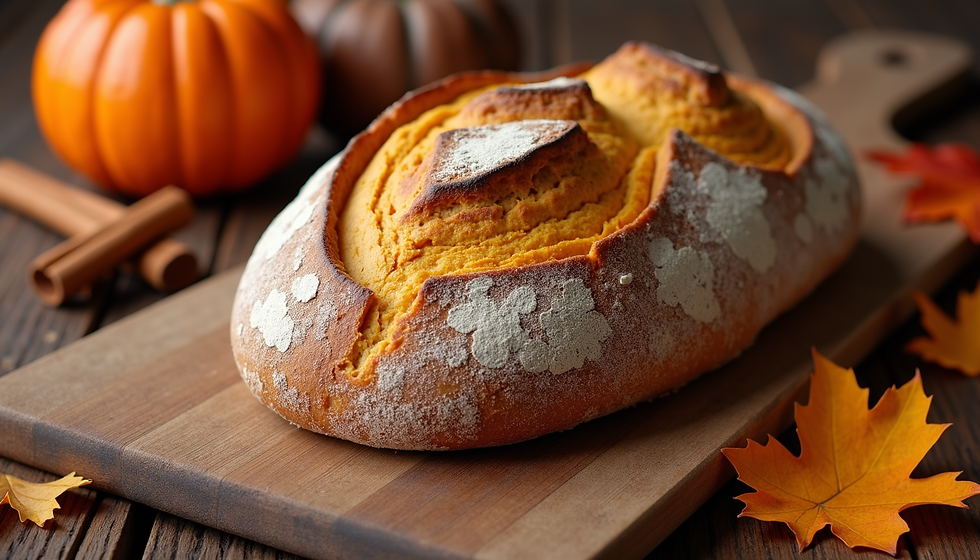Understanding Sourdough Bread Terms: A Beginner’s Guide
- STUpendous

- May 4
- 3 min read
If you’re diving into the world of naturally leavened bread, understanding the vocabulary is key to mastering the process. Sourdough isn’t just about mixing flour, water, and salt—it’s about timing, technique, and intuition. And that intuition comes faster when you understand the sourdough bread terms used by bakers worldwide.
Let’s break down the most commonly used terminology, from starter to oven spring, so you can bake with confidence.

Starter (aka Levain)
The heart of every sourdough recipe, your starter is a living culture of flour and water that captures wild yeast and bacteria from your environment. It’s the natural leavening agent that replaces commercial yeast and gives sourdough its complex flavor and chewy texture.
To keep your starter active, you’ll need to feed it regularly—usually once or twice a day. That means discarding some of the starter (called, predictably, the discard) and adding fresh flour and water.
Levain is sometimes used to describe a specific offshoot of your starter that’s mixed and fermented separately for a bake. Not all bakers make a levain, but it can be useful for tailoring hydration or flour blends.
Feeding and Discard
Feeding is simply refreshing your starter with fresh flour and water. This helps keep the wild yeast active and ready to ferment your dough. You’ll typically remove a portion of the starter before feeding—this is your discard.
Don’t throw it away! Discard can be used in pancakes, crackers, and other bakes that don’t require leavening.
Bulk Fermentation
After mixing your dough (flour, water, starter, and salt), it enters its first rise—known as bulk fermentation. This is when the yeast and bacteria in your starter begin to digest sugars in the flour, releasing carbon dioxide that causes the dough to rise.
During this stage, gluten is strengthened, flavor is developed, and the dough becomes airy and elastic. Depending on the temperature and recipe, bulk fermentation can last anywhere from 3 to 6 hours.
Stretch and Fold
Rather than kneading, sourdough bakers often use the stretch and fold method to strengthen the dough. At intervals during bulk fermentation, you’ll gently pull one side of the dough and fold it over itself. This helps align the gluten strands without deflating the dough.
Another variation is the coil fold, which gently lifts and coils the dough under itself—perfect for high-hydration doughs.
Proofing & Retarding
After shaping your dough, it enters the final rise, called proofing. This can happen at room temperature or in the refrigerator. If you refrigerate the dough to slow fermentation, that’s called retarding—and it can develop more complex flavors and make scoring easier.
A banneton or proofing basket helps hold your dough’s shape during this stage, often leaving beautiful flour rings on the crust.
Scoring & Baking
Right before baking, you’ll use a sharp blade or lame to score the dough. These cuts direct the expansion of the dough in the oven, giving you that dramatic oven spring and signature design.
Once the dough hits a hot, steamy oven, the trapped gases expand rapidly. This burst of rise is known as oven spring. To help it along, many bakers bake in a Dutch oven or add water to the oven for the first 15–20 minutes.
Crust & Crumb
The crust is the outer shell of your loaf—crackly, golden, and deeply flavorful when done right. The crumb is the inside of the bread—open, chewy, and full of irregular holes in a well-fermented loaf.
A tighter crumb isn’t a failure—it often indicates a lower hydration or shorter fermentation and can be perfect for sandwiches or toast.
Why These Sourdough Bread Terms Matter
When you understand the terminology, you’re not just following a recipe—you’re building your baking instincts. Words like “bulk fermentation,” “proof,” and “retard” stop being intimidating and start becoming signals that help guide you through the process.
Save the reference image below, pin this post, and revisit it whenever you need a quick refresher.
Have more sourdough questions? Drop them in the comments or follow along on TikTok at @neurodivergence4thewin for real-time tips, demos, and behind-the-scenes footage from my microbakery!





Comments